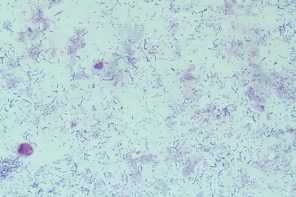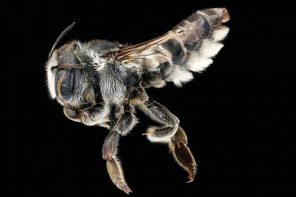By: Jay Evans, USDA Beltsville Bee Lab
When it comes to microbes in honey bee colonies, the bad guys get all the press. Since Aristotle there have been countless discussions of foul scourges, blights, and paralyzing viruses that afflict bees. More benign microbes have received far less attention, if they were noticed at all. This is no longer the case. While there continue to be advances in understanding honey bee pests and pathogens, the real frontier for over a decade has involved bacteria and fungi that do not appear on bee health alerts, and are rarely mentioned in beekeeping meetings or books. Work on these ‘other’ bee microbes gained some footing thanks to the careful description of hundreds of microbial isolates by Dr. Martha Gilliam with the USDA in Tucson, Arizona.
Dr. Gilliam was especially active in the 1970’s and 1980’s and, while her job also required her to study the diseases of the time, her real passion was for the many unsung microbes in honey bee nutrition. Her work, some of which is detailed at https://www.researchgate.net/scientific-contributions/73309614_Martha_Gilliam, echoes that of a birder or botanist collecting samples throughout the Amazon. Her passion was to grow any and all of the bee-associated and flower-associated microbes in Petri dishes in a sterile laboratory. She isolated hundreds of types of microbes, carefully documenting where each was found, possible impacts on bees or bee products, and the overall diversity of microbial communities.
Along with dissecting thousands of bees and flowers, this work used dozens of nutrient recipes and conditions to nurse microbes to grow, followed by many hours of microscopy and chemical tests aimed at putting a name on isolated microbes.
After Gilliam’s work there was a bit of a lull in the study of microbes in the hive until the enigmatic Colony Collapse Disorder in late 2006. Suddenly, everything was a suspect again, since the usual suspects were not noticeably associated with all the fuss and disorder. Consequently, there was renewed interest in scouting the full microbial world for causes of bee illness.
Fortunately, Professor Nancy Moran, also in Tucson at the time but at the University of Arizona, was lured into this fray. Moran had carried out many years of critical work on microbes tied to aphids and other insects and came to the bee fold with new insights and great passion. In the past decade, she and her students and colleagues have made game-changing advances in the understanding of bacteria tied to the honey bee digestive tract (Google Scholar is one place to start to see some of her work on the microbes of bees and other insects, or you can check out her Lab Page at her new home, the University of Texas, http://web.biosci.utexas.edu/moran/index.html).
Collectively, they have named almost all of the key bacteria in the bee gut, tapping into bee science for names, including ‘Gilliamella,’ ‘Frischella,’ and ‘Snodgrassella,’ as nods to previous researchers. More importantly, they have carried out fundamental work implicating bacteria in everything from nutrition to pest resistance. These bacteria have their own lives and need not be helpful for bee health, but in fact most of them seem to have a net positive effect on their bee hosts.
Moran’s group has also shown how human actions, from antibiotics to pesticides, can impact gut microbes and the bees that rely on them. They have also greatly energized the field of bee probiotics, an evolving topic I attempted to review here in 2017 (https://www.beeculture.com/found-in-translation-2/).
In a technical breakthrough just this month, Moran and colleagues used one of these resident bacteria, Snodgrassella alvi, as a vessel for delivering gene products that interfere with specific bee proteins, mites, and viruses. This work, led by graduate student Sean Leonard with a team of scientists from Texas, combines the power of RNA interference, a widespread mechanism for controlling genes and pathogens, with a bold attempt to tweak the cells of Snodgrassella to make a novel gene product (Leonard, S.P., Powell, J.E., Perutka, J., Geng, P., Heckmann, L.C., Horak, R.D., Davies, B.W., Ellington, A.D., Barrick, J.E., Moran, N.A. (2020) Engineered symbionts activate honey bee immunity and limit pathogens, Science, 367 (6477), pp. 573-576. doi: 10.1126/science.aax9039).
RNA interference has been used in bees before, and researchers have added genetic parts to bee bacteria, but neither approach was as powerful for bee biology and health until they were married together.
In brief, genetically modified(GMO) Snodgrassella were produced in three flavors, one that knocked back a honey bee protein, one that targeted Deformed wing virus, and one that targeted snippets from 14 different genes in the Varroa mite. In all cases, the targets were hit and bees did better as a result. Further, the modified bacteria persisted in individual bees and social groups (all of these experiments were carried out on worker bees in the lab, not in colonies).
This paper has stirred much discussion already on possibly using this technology to improve bee health, and this is a noble direction. Still, much remains to be resolved. How long will these GMO engineered bacteria persist in colonies? How long will it take for viruses and mites to evolve resistance? How will these modified GMO bacteria behave over the long-term, and will there be a way to reel things in if they somehow go awry? Will beekeepers and consumers of hive products be OK with this? These questions are being taken seriously by researchers, including Moran’s team, and regulators. Like many scientific breakthroughs, this one might remain ‘good news for lab bees’ for some time before it is deployed against one or more bee challenges, if it is at all. Still, the science in this work is beautiful and some of the best in the business are working to see where this goes for bee health.








